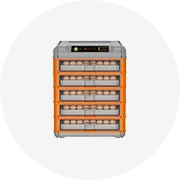Types of 4000 CFM Radiator Fans
Radiator fans are crucial components that create the necessary airflow for proper engine cooling. With a capacity of 4000 CFM (Cubic Feet per Minute), these powerful fans are suitable for high-performance vehicles and demanding cooling applications.
Electric Radiator Fans
Electric fans are the most common type of 4000 CFM radiator fans found in modern vehicles. They draw power directly from the vehicle's electrical system and are controlled by temperature sensors or manually by the driver.
Key Benefits:
- Superior fuel efficiency
- Reduced noise levels
- Independent operation from engine speed
- Optimal temperature regulation
Mechanical Radiator Fans
Mechanical fans are driven by the engine's crankshaft through belts or direct connection. These are more common in older vehicle models but still have applications in specific scenarios.
Key Benefits:
- Higher reliability
- No dependency on electrical system
- Simpler design with fewer components to fail
- Lower initial cost in many cases
Dual Fan Systems
A dual fan setup consists of two fans working in tandem to maximize cooling capacity. These systems are particularly valuable for high-performance vehicles or in applications where optimal cooling is critical.
Key Benefits:
- Enhanced cooling capacity
- Better distribution of airflow
- Redundancy if one fan fails
- Ideal for modified engines with higher heat output
Expert Tip: The 16-inch fan is the most common size for 4000 CFM applications, providing substantial cooling capacity for trucks and heavy-duty applications where efficient cooling is crucial.
Specifications of 4000 CFM Radiator Fans
Understanding the technical specifications of 4000 CFM radiator fans is essential for selecting the right fan for your specific application and ensuring optimal performance.
| Specification | Description | Importance |
|---|---|---|
| Size & Mounting | Measured in inches/mm; includes mounting bracket details | Critical for proper fitment in the engine bay |
| Airflow Capacity | Measured in CFM (4000 cubic feet per minute) | Determines cooling efficiency |
| Noise Level | Measured in decibels (dB) | Affects driving comfort and vehicle acoustics |
| Power Consumption | Measured in watts, voltage, and current requirements | Impacts electrical system load |
| Speed Control | Fixed speed vs. variable speed (PWM) | Affects efficiency and noise levels |
| Bearing Type | Ball, sleeve, or fluid dynamic bearings | Impacts durability and noise |
| Blade Design | Number of blades, shape, and pitch angle | Affects airflow efficiency and noise |
| Motor Type | Shaded pole, PSC, or brushless DC | Determines reliability and efficiency |
| Material | Plastic, metal, or composite construction | Impacts durability and weight |
4000 CFM provides exceptional cooling for high-performance applications
Advanced speed control allows for precise temperature management
Proper cooling extends engine longevity and maintains performance
Maintenance of 4000 CFM Radiator Fans
Proper maintenance of your 4000 CFM radiator fan is essential for ensuring optimal performance, longevity, and reliable operation. Following a regular maintenance schedule will prevent costly repairs and maintain cooling efficiency.
Maintenance Checklist
-
Regular Inspection
Frequently check for visible signs of wear, damage, or abnormalities in the fan blades, motor, and electrical connections.
-
Thorough Cleaning
Remove dust, debris, and contaminants from the fan blades and surrounding area using a soft brush, cloth, and mild cleaning solution.
-
Proper Lubrication
Apply manufacturer-recommended lubricant to the fan motor bearings according to the specified schedule.
-
Electrical Connection Check
Verify all power connections are tight and secure, and inspect cables for signs of wear, damage, or corrosion.
-
Fan Blade Alignment
Ensure fan blades are correctly aligned and properly spaced to prevent noise, reduced performance, and uneven airflow.
-
Performance Monitoring
Track changes in airflow, noise levels, or temperature regulation that might indicate underlying issues.
-
Worn Part Replacement
Replace damaged components with manufacturer-recommended parts when repair is not possible.
Warning: Always disconnect the battery before performing maintenance on your radiator fan to prevent electrical hazards and potential injury from the fan activating unexpectedly.
| Maintenance Task | Frequency | Tools Required |
|---|---|---|
| Visual Inspection | Monthly | Flashlight |
| Cleaning | Every 3 months or as needed | Soft brush, cloth, mild cleaner |
| Lubrication Check | Every 6 months | Manufacturer-recommended lubricant |
| Electrical Inspection | Every 6 months | Multimeter, insulation tape |
| Performance Testing | Annually | Temperature gauge |
How to Choose the Right 4000 CFM Radiator Fan
Selecting the ideal 4000 CFM radiator fan requires careful consideration of your vehicle's specific needs and operating conditions. These powerful cooling fans move 4,000 cubic feet of air per minute, making them suitable for high-performance applications.
Expert Advice: Before selecting a fan, conduct a thorough assessment of your vehicle's cooling needs based on engine size, performance modifications, and typical operating conditions.
Vehicle Specifications
Consider your vehicle's make, model, engine type, and cooling system design. Larger engines generate more heat and require more powerful cooling solutions.
- Large V8 engines often require 4000+ CFM
- Modified engines may need additional cooling
- Towing vehicles benefit from higher CFM fans
Installation Constraints
Evaluate the available space in your engine bay and ensure the fan's dimensions are compatible with your radiator setup.
- Measure available clearance in all dimensions
- Consider mounting options and bracket compatibility
- Account for obstacles that might restrict airflow
Key Selection Criteria
- Airflow Requirements: 4000 CFM fans are ideal for large engines, high-performance vehicles, trucks, or vehicles used for towing or hauling. Smaller or more efficient vehicles may not need this level of cooling capacity.
- Space Availability: Ensure the fan fits properly within your engine bay without obstructing other components. Consider both the fan's diameter and depth.
- Noise Level: Higher CFM fans typically produce more noise. If this is a concern, look for models with noise-reducing features or variable speed operation.
- Durability and Reliability: Select fans constructed from high-quality materials that can withstand the harsh engine bay environment. Quality bearings and motors will reduce the need for frequent replacements.
- Power Consumption: 4000 CFM fans draw significant electrical power. Verify your vehicle's electrical system can handle the additional load, especially during extended operation.
- Budget Considerations: Higher CFM fans are typically more expensive. Balance your cooling needs with budget constraints to find the optimal solution.
| Vehicle Type | Recommended Fan Type | Typical Budget Range |
|---|---|---|
| Standard Passenger Car | Single Electric Fan (2000-3000 CFM) | $70-150 |
| Performance Vehicle | High Output Electric Fan (4000 CFM) | $150-250 |
| Truck/SUV | Heavy-Duty Electric Fan (4000+ CFM) | $200-300 |
| Towing/Hauling Vehicle | Dual Electric Fan System (Combined 5000-8000 CFM) | $250-400 |
| Racing Application | Lightweight High-Performance Fan (4000+ CFM) | $300-500+ |
DIY Replacement of 4000 CFM Radiator Fan
Replacing your radiator fan is a straightforward DIY project that can save you significant repair costs. With basic mechanical knowledge and simple tools, you can install a new 4000 CFM electric fan and improve your vehicle's cooling efficiency.
Step-by-Step Installation Guide
-
Prepare Your Vehicle
Turn off the ignition and disconnect the negative terminal of the battery to prevent electrical hazards.
-
Drain the Coolant
Place a drain pan under the radiator and open the drain valve to remove coolant and prevent spillage during fan replacement.
-
Remove the Old Fan
Locate and remove the mounting screws or bolts securing the fan assembly to the radiator or engine bay.
-
Disconnect Electrical Connections
Carefully disconnect the fan's electrical connector, taking note of the wiring configuration for reconnection later.
-
Install the New Fan
Position the new 4000 CFM fan in place and secure it with the mounting bolts, ensuring proper alignment with the radiator.
-
Reconnect Electrical Components
Connect the electrical connector to the new fan and ensure all wiring is properly secured away from moving parts.
-
Refill the Cooling System
Close the drain valve and refill the radiator with the appropriate coolant mixture to the manufacturer's specified level.
-
Test Operation
Reconnect the battery, start the engine, and verify the new fan operates correctly when the engine reaches operating temperature.
Important Safety Note: Allow the engine to cool completely before beginning this installation to avoid burns from hot coolant or engine components.
Pro Tip: Consider upgrading your fan relay when installing a high-performance 4000 CFM fan. Standard relays may not be rated for the increased current draw of larger fans.
Tools Required
Basic Tools
- Screwdriver set (flathead and Phillips)
- Socket wrench set with extensions
- Pliers and wire cutters
- Drain pan for coolant
Additional Helpful Items
- Wire connectors and electrical tape
- Zip ties for securing wires
- Multimeter for electrical testing
- Work gloves and safety glasses
Frequently Asked Questions
CFM stands for Cubic Feet per Minute, which measures the volume of air a fan can move in one minute. This standardized measurement indicates the cooling effectiveness of a radiator fan. A 4000 CFM fan can move 4,000 cubic feet of air per minute, providing substantial cooling capacity for high-performance applications.
A 4000 CFM fan provides excellent cooling capacity for most automotive applications. These high-output fans are particularly beneficial for:
- Large displacement engines (V8s, diesel engines)
- Performance-modified vehicles
- Trucks and SUVs used for towing
- Vehicles operated in hot climates
For smaller engines or standard passenger cars with factory specifications, a 4000 CFM fan might be more than necessary. Consider your vehicle's specific cooling requirements before making a selection.
| CFM Rating | Typical Applications | Advantages | Disadvantages |
|---|---|---|---|
| 2000-3000 CFM | Standard passenger cars, small engines | Lower power consumption, quieter operation | May be insufficient for high-performance needs |
| 4000 CFM | Performance vehicles, trucks, towing applications | Excellent cooling capacity, good balance of power and performance | Higher power draw, can be louder |
| 5000+ CFM | Heavy-duty applications, racing, extreme conditions | Maximum cooling performance | Very high power consumption, significant noise, may require electrical system upgrades |
Theoretically, CFM can be calculated by multiplying the airflow velocity by the cross-sectional area of the fan. The formula is:
CFM = Air Velocity (ft/min) × Fan Area (sq ft)
However, this provides only a theoretical value. For accurate CFM measurements, specialized equipment like a CFM meter or anemometer is required. Most manufacturers provide the CFM rating for their fans based on controlled testing, which is typically the most reliable figure to use when selecting a fan.
A higher CFM rating isn't automatically better for all applications. While increased airflow can provide better cooling, it comes with tradeoffs:
- Advantages of higher CFM: Better cooling capacity, improved performance in extreme conditions, more effective for modified engines
- Disadvantages of higher CFM: Increased power consumption, higher noise levels, potential strain on the electrical system, higher cost
The optimal CFM rating depends on your specific cooling requirements. For most standard vehicles, a fan with 2000-3000 CFM is sufficient. Performance vehicles and those used for towing benefit from 4000 CFM fans, while specialized applications may require even higher airflow.
It's important to match the fan's CFM rating to your vehicle's specific needs rather than simply choosing the highest available rating.




























































































































































































































































 浙公网安备 33010002000092号
浙公网安备 33010002000092号 浙B2-20120091-4
浙B2-20120091-4